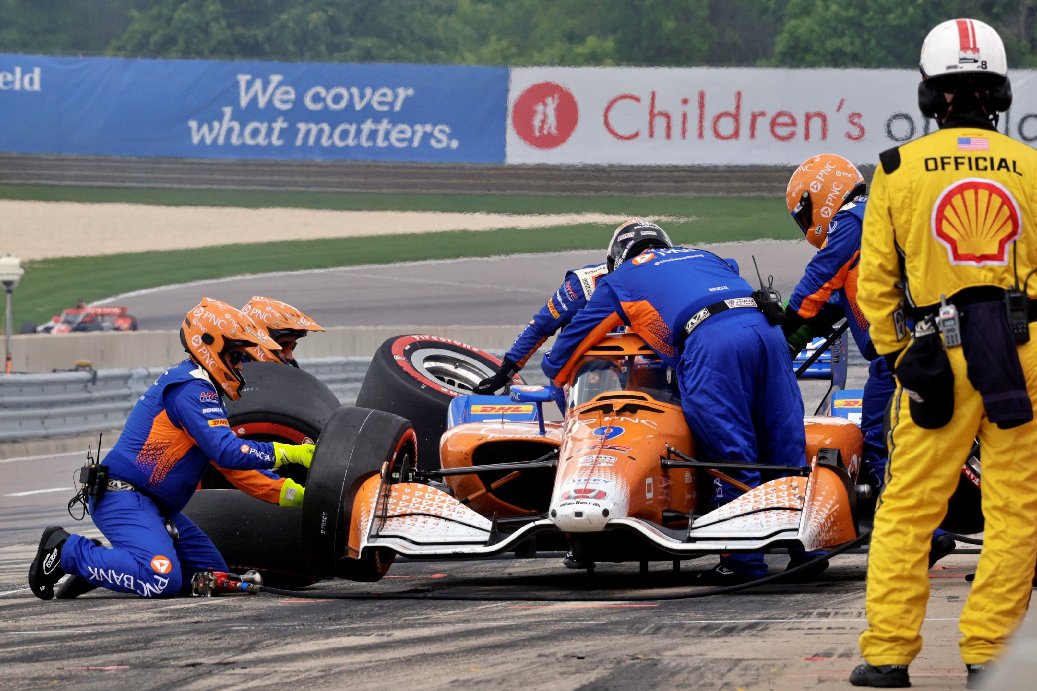Pit Stop Challenges at Barber Motorsports Park: A Formula Indy Overview
The atmosphere in the pits during the Children’s of Alabama Grand Prix at Barber Motorsports Park was anything but inviting, with a sign that read, “Enter at your own risk.” This race, broadcasted on platforms like TV Cultura, ESPN3, and Disney+, turned into a treacherous battleground for IndyCar teams. Pit stops became a significant factor in determining the outcome of the race, showcasing a mix of slow stops, disastrous mishaps, and even instances where wheel nuts mysteriously vanished.
Amidst the chaos, Scott Dixon and his crew from Chip Ganassi Racing emerged as a beacon of efficiency. The New Zealander clocked an impressive average pit stop time of 29.0689 seconds and achieved the fastest single stop at just 28.0144 seconds. Close behind him, Scott McLaughlin from Team Penske demonstrated that when everything aligns, the margin between success and disaster can be as slim as mere tenths of a second.
However, while some drivers soared, others faced significant setbacks. Jacob Abel from Dale Coyne Racing experienced a particularly painful moment during the race. His second pit stop dragged on for an agonizing 43.7868 seconds—almost 16 seconds longer than Dixon’s pit stop—due to a lost wheel nut. This unfortunate delay left him in last place by the race’s conclusion. In their official statement, the team opted to emphasize the “new tire strategy,” but the reality of the situation was far more difficult to digest.
PREMA Racing also encountered its share of challenges. Callum Ilott finished the race with a pit stop that took 37.8 seconds, averaging 34.8 seconds. This extra time spent in the pits cost him critical positions on the track. Even Kyle Kirkwood, who had previously triumphed in Long Beach, faced frustration during this race. His pit stop lasted 36.6 seconds due to a stubborn tire, which was nearly 6 seconds longer than what his team typically manages.
What can be learned from these events? In the world of IndyCar racing, every second spent in the pits can significantly impact the race’s outcome. At Barber Motorsports Park, some teams faced their worst moments, while others capitalized on the opportunity. For viewers, this serves as a reminder that the thrill and tension of racing extend far beyond the track itself, as drama unfolds in the pits just as intensely as during overtakes on the course.
The Significance of Pit Stops in IndyCar Racing
Pit stops are a critical component of any IndyCar race, affecting both strategy and performance. Teams must work efficiently and effectively to minimize the time spent in the pits, as any delay can lead to lost positions and missed opportunities. The Children’s of Alabama Grand Prix showcased how essential these moments can be, as drivers and teams battled not only their competitors but also the clock.
The process of a pit stop involves several key elements, including tire changes, refueling, and adjustments to the car. Each of these tasks must be executed flawlessly, often under intense pressure. A well-executed pit stop can provide a driver with a crucial edge, while a mishap can spell disaster.
Analyzing the Performance
Scott Dixon’s performance during the race exemplifies the importance of a smooth pit stop. His team’s ability to execute a quick and efficient stop not only aided his performance on the track but also set a benchmark for others to aspire to. In contrast, Jacob Abel’s struggle serves as a cautionary tale of how quickly fortunes can change in the high-stakes environment of IndyCar racing.
The contrast between the top teams and those struggling highlights the competitive nature of the series. Teams like Chip Ganassi Racing and Team Penske have established themselves as leaders in not only driver skill but also in pit stop execution. Their consistent performance in the pits can be a decisive factor in their overall success during the season.
Lessons Learned from Pit Stop Mishaps
The Children’s of Alabama Grand Prix provided several lessons on the impact of pit stops. For one, it underscored the necessity of teamwork and communication. Every member of the crew plays a vital role during a pit stop, and any miscommunication can lead to delays and mistakes.
Additionally, the race illustrated the importance of preparation and practice. Teams that invest time in rehearsing pit stops and refining their strategies are better positioned to succeed when it matters most. The high level of competition in IndyCar means that even minor improvements can lead to significant advantages on race day.
The Emotional Rollercoaster of Racing
For both teams and fans, the emotional stakes of racing are incredibly high. The tension during pit stops can be palpable, as crew members anxiously await the outcome of their efforts. A successful stop can lead to jubilation, while a failed one can result in heartbreak. For spectators, the drama of these moments adds a layer of excitement to the racing experience.
The Children’s of Alabama Grand Prix highlighted how crucial these moments in the pits can be. As teams navigated through the challenges, it became clear that every second counts in IndyCar racing. The thrill of the competition extends beyond the track, encompassing the entire experience of the race.
Conclusion
In summary, the Children’s of Alabama Grand Prix at Barber Motorsports Park showcased the critical role of pit stops in IndyCar racing. With teams facing a variety of challenges, from timing issues to equipment failures, the race served as a vivid reminder of the complexities of this high-speed sport. Scott Dixon and Chip Ganassi Racing’s exemplary performance stood in stark contrast to the struggles of others, illustrating the fine line between success and failure in the world of racing. With each race presenting new opportunities and challenges, the excitement of IndyCar continues to captivate fans and participants alike.
